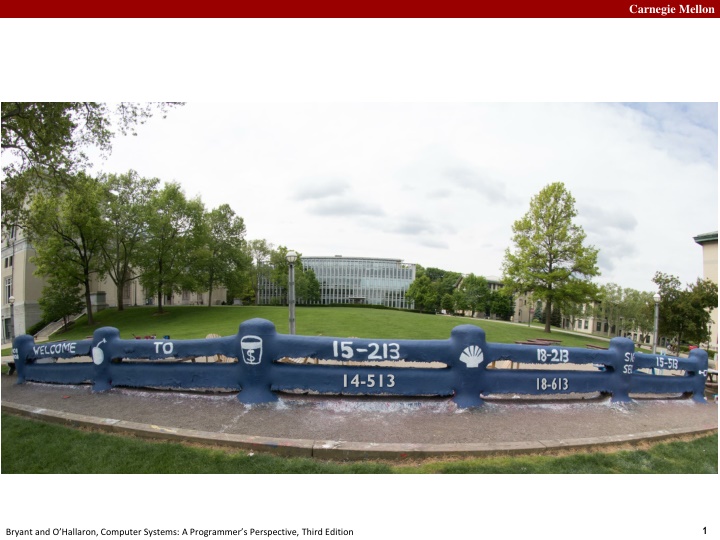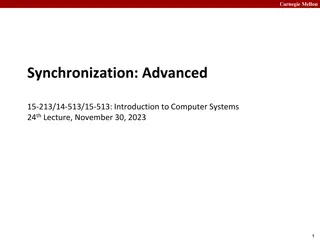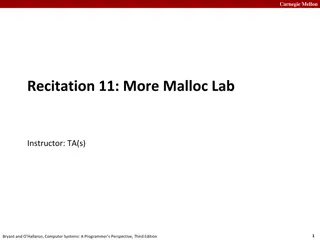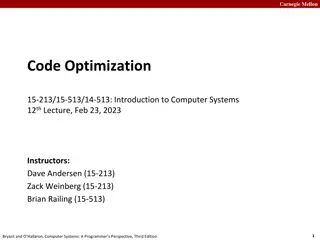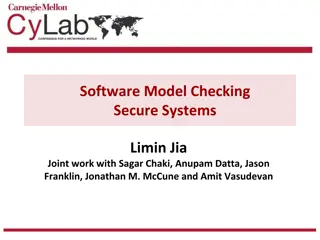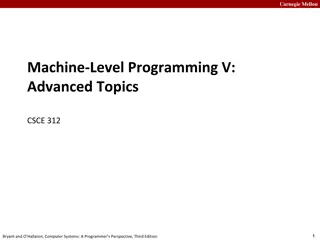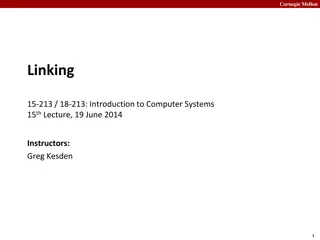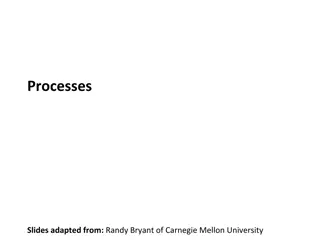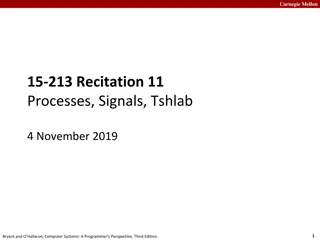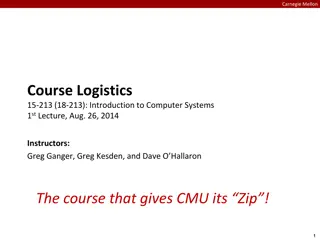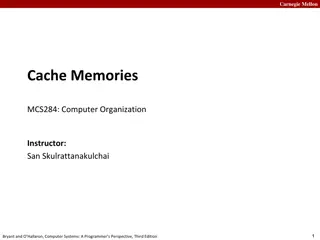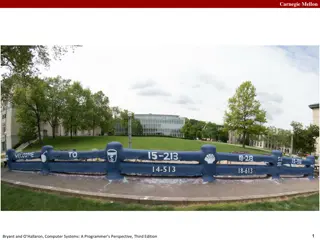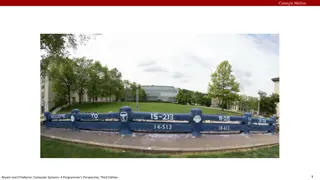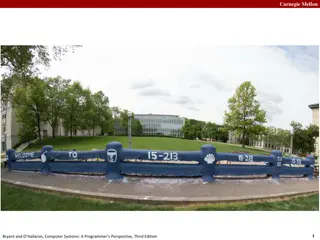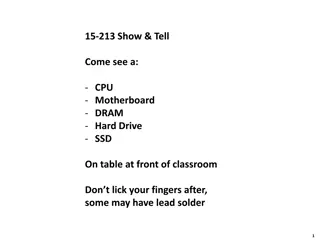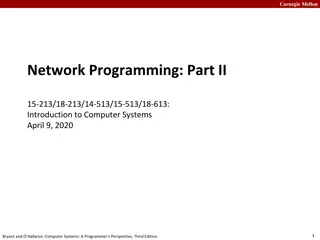Computer Systems: A Programmer's Perspective at Carnegie Mellon
In this material, you will delve into network programming, network layers, anatomy of connections, socket interfaces, and more. Explore the fundamentals of computer systems with a third edition perspective at Carnegie Mellon University. Learn about network applications, Internet protocols, Unix distribution, and modern system support.
Download Presentation

Please find below an Image/Link to download the presentation.
The content on the website is provided AS IS for your information and personal use only. It may not be sold, licensed, or shared on other websites without obtaining consent from the author.If you encounter any issues during the download, it is possible that the publisher has removed the file from their server.
You are allowed to download the files provided on this website for personal or commercial use, subject to the condition that they are used lawfully. All files are the property of their respective owners.
The content on the website is provided AS IS for your information and personal use only. It may not be sold, licensed, or shared on other websites without obtaining consent from the author.
E N D
Presentation Transcript
Carnegie Mellon 14-513 18 18- -613 613 1 Bryant and O Hallaron, Computer Systems: A Programmer s Perspective, Third Edition
Carnegie Mellon Network Programming: Part I 18-213/18-613: Introduction to Computer Systems 23th Lecture, Jul 27nd, 2023 2 Bryant and O Hallaron, Computer Systems: A Programmer s Perspective, Third Edition
Carnegie Mellon Today Network Layers: Birds Eye View The Sockets Interface CSAPP 11.4 CSAPP 11.5.1-11.5.3 CSAPP 11.6 CSAPP 11.5.4 Web Servers The Tiny Web Server Serving Dynamic Content Proxy Servers 3 Bryant and O Hallaron, Computer Systems: A Programmer s Perspective, Third Edition
Carnegie Mellon Today Network Layers: Birds Eye View The Sockets Interface CSAPP 11.4 CSAPP 11.5.1-11.5.3 CSAPP 11.6 CSAPP 11.5.4 Web Servers The Tiny Web Server Serving Dynamic Content Proxy Servers 4 Bryant and O Hallaron, Computer Systems: A Programmer s Perspective, Third Edition
Carnegie Mellon Recall: Anatomy of a Connection A connection is uniquely identified by the socket addresses of its endpoints (socket pair) (cliaddr:cliport, servaddr:servport) Client socket address 128.2.194.242:51213 Server socket address 208.216.181.15:80 Server (port 80) Client Connection socket pair (128.2.194.242:51213, 208.216.181.15:80) Client host address 128.2.194.242 Server host address 208.216.181.15 51213 is an ephemeral port allocated by the kernel 80 is a well-known port associated with Web servers 5 Bryant and O Hallaron, Computer Systems: A Programmer s Perspective, Third Edition
Carnegie Mellon Recall: Using Ports to Identify Services Server host 128.2.194.242 Client host Service request for 128.2.194.242:80 (i.e., the Web server) Web server (port 80) Client Kernel Echo server (port 7) Service request for 128.2.194.242:7 (i.e., the echo server) Web server (port 80) Client Kernel Echo server (port 7) 6 Bryant and O Hallaron, Computer Systems: A Programmer s Perspective, Third Edition
Carnegie Mellon Sockets Interface Set of system-level functions used in conjunction with Unix I/O to build network applications. Created in the early 80 s as part of the original Berkeley distribution of Unix that contained an early version of the Internet protocols. Available on all modern systems Unix variants, Windows, OS X, IOS, Android, ARM 7 Bryant and O Hallaron, Computer Systems: A Programmer s Perspective, Third Edition
Carnegie Mellon Sockets What is a socket? To the kernel, a socket is an endpoint of communication To an application, a socket is a file descriptor that lets the application read/write from/to the network Remember: All Unix I/O devices, including networks, are modeled as files Clients and servers communicate with each other by reading from and writing to socket descriptors Client Server clientfd serverfd The main distinction between regular file I/O and socket I/O is how the application opens the socket descriptors 8 Bryant and O Hallaron, Computer Systems: A Programmer s Perspective, Third Edition
Carnegie Mellon Representing a socket: Generic Socket Address Generic socket address: For address arguments to connect, bind, and accept struct sockaddr { uint16_t sa_family; /* Protocol family */ char sa_data[14]; /* Address data. */ }; sa_family Family Specific 9 Bryant and O Hallaron, Computer Systems: A Programmer s Perspective, Third Edition
Carnegie Mellon Representing a Socket: Socket Address Structures Internet (IPv4) specific socket address: Must cast (struct sockaddr_in *) to (struct sockaddr *) for functions that take socket address arguments. struct sockaddr_in { uint16_t sin_family; /* Protocol family (always AF_INET) */ uint16_t sin_port; /* Port num in network byte order */ struct in_addr sin_addr; /* IP addr in network byte order */ unsigned char sin_zero[8]; /* Pad to sizeof(struct sockaddr) */ }; sin_addr sin_port 0 0 0 0 0 0 0 0 AF_INET sa_family sin_family Family Specific 10 Bryant and O Hallaron, Computer Systems: A Programmer s Perspective, Third Edition
Carnegie Mellon 2. Start client Client 1. Start server Server Echo Server + Client Structure open_listenfd open_clientfd Connection request Await connection request from client accept 3. Exchange terminal read socket write socket read data Client / Server Session socket read terminal write socket write EOF socket read close 5. Drop client 4. Disconnect client close 11 Bryant and O Hallaron, Computer Systems: A Programmer s Perspective, Third Edition
Carnegie Mellon Start client Client Start server Server Sockets Interface getaddrinfo getaddrinfo socket socket open_listenfd open_clientfd bind listen Connection request connect accept rio_writen rio_readlineb Client / Server Session Await connection request from next client rio_readlineb rio_writen EOF rio_readlineb close close 12 Bryant and O Hallaron, Computer Systems: A Programmer s Perspective, Third Edition
Carnegie Mellon Host and Service Conversion: getaddrinfo getaddrinfo is the modern way to convert string representations of hostnames, host addresses, ports, and service names to socket address structures. Replaces obsolete gethostbyname and getservbyname funcs. Advantages: Reentrant (can be safely used by threaded programs). Allows us to write portable protocol-independent code Works with both IPv4 and IPv6 Disadvantages Somewhat complex Fortunately, a small number of usage patterns suffice in most cases. 13 Bryant and O Hallaron, Computer Systems: A Programmer s Perspective, Third Edition
Carnegie Mellon Host and Service Conversion: getaddrinfo int getaddrinfo(const char *host, /* Hostname or address */ const char *service, /* Port or service name */ const struct addrinfo *hints,/* Input parameters */ struct addrinfo **result); /* Output linked list */ void freeaddrinfo(struct addrinfo *result); /* Free linked list */ const char *gai_strerror(int errcode); /* Return error msg */ Given host and service, getaddrinfo returns result that points to a linked list of addrinfo structs, each of which points to a corresponding socket address struct, and which contains arguments for the sockets interface functions. Helper functions: freeadderinfo frees the entire linked list. gai_strerror converts error code to an error message. 14 Bryant and O Hallaron, Computer Systems: A Programmer s Perspective, Third Edition
Carnegie Mellon getaddrinfo getaddrinfo converts string representations of hostnames, host addresses, ports, service names to socket address structures addrinfo structs result SA list Socket address structs ai_canonname ai_addr ai_next NULL ai_addr ai_next NULL ai_addr NULL 15 Bryant and O Hallaron, Computer Systems: A Programmer s Perspective, Third Edition
Carnegie Mellon Host and Service Conversion: getnameinfo getnameinfo is the inverse of getaddrinfo, converting a socket address to the corresponding host and service. Replaces obsolete gethostbyaddr and getservbyport funcs. Reentrant and protocol independent. int getnameinfo(const SA *sa, socklen_t salen, /* In: socket addr */ char *host, size_t hostlen, /* Out: host */ char *serv, size_t servlen, /* Out: service */ int flags); /* optional flags */ 16 Bryant and O Hallaron, Computer Systems: A Programmer s Perspective, Third Edition
Carnegie Mellon Start server Server Start client Client Sockets Interface getaddrinfo getaddrinfo SA list SA list socket socket open_listenfd open_clientfd bind listen Connection request connect accept rio_writen rio_readlineb Client / Server Session Await connection request from next client rio_readlineb rio_writen EOF rio_readlineb close close 17 Bryant and O Hallaron, Computer Systems: A Programmer s Perspective, Third Edition
Carnegie Mellon Sockets Interface: socket Clients and servers use the socket function to create a socket descriptor: int socket(int domain, int type, int protocol) Example: int clientfd = socket(AF_INET, SOCK_STREAM, 0); Indicates that we are using 32-bit IPV4 addresses Indicates that the socket will be the end point of a reliable (TCP) connection Protocol specific! Best practice is to use getaddrinfo to generate the parameters automatically, so that code is protocol independent. 18 Bryant and O Hallaron, Computer Systems: A Programmer s Perspective, Third Edition
Carnegie Mellon Start server Server Sockets Interface Client getaddrinfo getaddrinfo SA list SA list socket socket open_listenfd listenfd clientfd open_clientfd bind listen Connection request connect accept rio_writen rio_readlineb Client / Server Session Await connection request from next client rio_readlineb rio_writen EOF rio_readlineb close close 19 Bryant and O Hallaron, Computer Systems: A Programmer s Perspective, Third Edition
Carnegie Mellon Sockets Interface: bind A server uses bind to ask the kernel to associate the server s socket address with a socket descriptor: int bind(int sockfd, SA *addr, socklen_t addrlen); Our convention:typedef struct sockaddr SA; Process can read bytes that arrive on the connection whose endpoint is addr by reading from descriptor sockfd Similarly, writes to sockfd are transferred along connection whose endpoint is addr 20 Bryant and O Hallaron, Computer Systems: A Programmer s Perspective, Third Edition
Carnegie Mellon Sockets Interface Client Server getaddrinfo getaddrinfo SA list SA list socket socket open_listenfd listenfd clientfd open_clientfd bind listenfd <-> SA listen Connection request connect accept rio_writen rio_readlineb Client / Server Session Await connection request from next client rio_readlineb rio_writen EOF rio_readlineb close close 21 Bryant and O Hallaron, Computer Systems: A Programmer s Perspective, Third Edition
Carnegie Mellon Sockets Interface: listen Kernel assumes that descriptor from socket function is an active socket that will be on the client end A server calls the listen function to tell the kernel that a descriptor will be used by a server rather than a client: int listen(int sockfd, int backlog); Converts sockfd from an active socket to a listening socket that can accept connection requests from clients. backlog is a hint about the number of outstanding connection requests that the kernel should queue up before starting to refuse requests (128-ish by default) 22 Bryant and O Hallaron, Computer Systems: A Programmer s Perspective, Third Edition
Carnegie Mellon Sockets Interface Client Server getaddrinfo getaddrinfo SA list SA list socket socket open_listenfd listenfd clientfd open_clientfd bind listenfd <-> SA listen Connection request listening listenfd connect accept rio_writen rio_readlineb Client / Server Session Await connection request from next client rio_readlineb rio_writen EOF rio_readlineb close close 23 Bryant and O Hallaron, Computer Systems: A Programmer s Perspective, Third Edition
Carnegie Mellon Sockets Interface: accept Servers wait for connection requests from clients by calling accept: int accept(int listenfd, SA *addr, int *addrlen); Waits for connection request to arrive on the connection bound to listenfd, then fills in client s socket address in addr and size of the socket address in addrlen. Returns a connected descriptor connfdthat can be used to communicate with the client via Unix I/O routines. 24 Bryant and O Hallaron, Computer Systems: A Programmer s Perspective, Third Edition
Carnegie Mellon Sockets Interface Client Server getaddrinfo getaddrinfo SA list SA list socket socket open_listenfd listenfd clientfd open_clientfd bind listenfd <-> SA listen Connection request listening listenfd connect accept rio_writen rio_readlineb Client / Server Session Await connection request from next client rio_readlineb rio_writen EOF rio_readlineb close close 25 Bryant and O Hallaron, Computer Systems: A Programmer s Perspective, Third Edition
Carnegie Mellon Sockets Interface: connect A client establishes a connection with a server by calling connect: int connect(int clientfd, SA *addr, socklen_t addrlen); Attempts to establish a connection with server at socket address addr If successful, then clientfd is now ready for reading and writing. Resulting connection is characterized by socket pair (x:y, addr.sin_addr:addr.sin_port) x is client address y is ephemeral port that uniquely identifies client process on client host Best practice is to use getaddrinfo to supply the arguments addr and addrlen. 26 Bryant and O Hallaron, Computer Systems: A Programmer s Perspective, Third Edition
Carnegie Mellon Connected vs. Listening Descriptors Listening descriptor End point for client connection requests Created once and exists for lifetime of the server Connected descriptor End point of the connection between client and server A new descriptor is created each time the server accepts a connection request from a client Exists only as long as it takes to service client Why the distinction? Allows for concurrent servers that can communicate over many client connections simultaneously E.g., Each time we receive a new request, we fork a child to handle the request 27 Bryant and O Hallaron, Computer Systems: A Programmer s Perspective, Third Edition
Carnegie Mellon Sockets Interface Client Server getaddrinfo getaddrinfo SA list SA list socket socket open_listenfd listenfd clientfd open_clientfd bind listenfd <-> SA listen Connection request listening listenfd connect accept connected (to SA) clientfd connected connfd rio_writen rio_readlineb Client / Server Session Await connection request from next client rio_readlineb rio_writen EOF rio_readlineb close close 28 Bryant and O Hallaron, Computer Systems: A Programmer s Perspective, Third Edition
Carnegie Mellon Sockets Interface Client Server getaddrinfo getaddrinfo socket socket open_listenfd open_clientfd bind listen Connection request connect accept rio_writen rio_readlineb Client / Server Session Await connection request from next client rio_readlineb rio_writen EOF rio_readlineb close close 29 Bryant and O Hallaron, Computer Systems: A Programmer s Perspective, Third Edition
Carnegie Mellon Sockets Interface Client Server getaddrinfo getaddrinfo socket socket open_listenfd open_clientfd bind listen Connection request connect accept rio_writen rio_readlineb Client / Server Session Await connection request from next client rio_readlineb rio_writen EOF rio_readlineb close close 32 Bryant and O Hallaron, Computer Systems: A Programmer s Perspective, Third Edition
Carnegie Mellon Testing Servers Using telnet The telnet program is invaluable for testing servers that transmit ASCII strings over Internet connections Our simple echo server Web servers Mail servers Usage: linux> telnet <host> <portnumber> Creates a connection with a server running on <host>and listening on port <portnumber> 36 Bryant and O Hallaron, Computer Systems: A Programmer s Perspective, Third Edition
Carnegie Mellon Testing the Echo Server With telnet whaleshark> ./echoserveri 18213 Connected to (MAKOSHARK.ICS.CS.CMU.EDU, 50280) server received 11 bytes server received 8 bytes makoshark> telnet whaleshark.ics.cs.cmu.edu 18213 Trying 128.2.210.175... Connected to whaleshark.ics.cs.cmu.edu (128.2.210.175). Escape character is '^]'. Hi there! Hi there! Howdy! Howdy! ^] telnet> quit Connection closed. makoshark> 37 Bryant and O Hallaron, Computer Systems: A Programmer s Perspective, Third Edition
Carnegie Mellon Today Network Layers: Birds Eye View The Sockets Interface CSAPP 11.4 CSAPP 11.5.1-11.5.3 CSAPP 11.6 CSAPP 11.5.4 Web Servers The Tiny Web Server Serving Dynamic Content Proxy Servers 38 Bryant and O Hallaron, Computer Systems: A Programmer s Perspective, Third Edition
Carnegie Mellon Web Server Basics HTTP request Clients and servers communicate using the HyperText Transfer Protocol (HTTP) Client and server establish TCP connection Client requests content Server responds with requested content Client and server close connection (eventually) Web client (browser) Web server HTTP response (content) HTTP Web content TCP Streams Current version is HTTP/1.1 RFC 2616, June, 1999. HTTP/2 is so different that it might as well be a new protocol. IP Datagrams http://www.w3.org/Protocols/rfc2616/rfc2616.html 39 Bryant and O Hallaron, Computer Systems: A Programmer s Perspective, Third Edition
Carnegie Mellon Web Content Web servers return content to clients content: a sequence of bytes with an associated MIME (Multipurpose Internet Mail Extensions) type Content is identified by its URL (Uniform Resource Locator) Example MIME types text/html text/plain image/gif image/png image/jpeg HTML document Unformatted text Binary image encoded in GIF format Binary image encoded in PNG format Binary image encoded in JPEG format You can find the complete list of MIME types at: http://www.iana.org/assignments/media-types/media-types.xhtml 40 Bryant and O Hallaron, Computer Systems: A Programmer s Perspective, Third Edition
Carnegie Mellon Static and Dynamic Content Static content: content stored in files and retrieved in response to an HTTP request Examples: HTML files, images, audio clips, Javascript programs Request identifies which content file Dynamic content: content produced on-the-fly in response to an HTTP request Example: content produced by a program executed by the server on behalf of the client Request identifies file containing executable code Any URL can refer to either static or dynamic content 41 Bryant and O Hallaron, Computer Systems: A Programmer s Perspective, Third Edition
Carnegie Mellon URLs and how clients and servers use them Unique name for a file: URL (Universal Resource Locator) Example URL: http://www.cmu.edu:80/index.html Clients use prefix (http://www.cmu.edu:80) to infer: What kind (protocol) of server to contact (HTTP) Where the server is (www.cmu.edu) What port it is listening on (80) Servers use suffix (/index.html) to: Determine if request is for static or dynamic content. No hard and fast rules for this One convention: executables reside in cgi-bindirectory Find file on file system Initial / in suffix denotes home directory for requested content. Minimal suffix is / , which server expands to configured default filename (usually, index.html) 42 Bryant and O Hallaron, Computer Systems: A Programmer s Perspective, Third Edition
Carnegie Mellon HTTP Requests HTTP request is a request line, followed by zero or more request headers Request line: <method> <uri> <version> <method> is one of GET, POST, OPTIONS, HEAD, PUT, DELETE, orTRACE <uri>is typically URL for proxies, URL suffix for servers A URL is a type of URI (Uniform Resource Identifier) See http://www.ietf.org/rfc/rfc2396.txt <version>is HTTP version of request (HTTP/1.0 or HTTP/1.1) Request headers: <header name>: <header data> Provide additional information to the server 43 Bryant and O Hallaron, Computer Systems: A Programmer s Perspective, Third Edition
Carnegie Mellon HTTP Responses HTTP response is a response line followed by zero or more response headers, possibly followed by content, with blank line ( \r\n ) separating headers from content. Response line: <version> <status code> <status msg> <version> is HTTP version of the response <status code> is numeric status <status msg> is corresponding English text 200 OK Request was handled without error 301 Moved Provide alternate URL 404 Not found Server couldn t find the file Response headers: <header name>: <header data> Provide additional information about response Content-Type: MIME type of content in response body Content-Length: Length of content in response body 44 Bryant and O Hallaron, Computer Systems: A Programmer s Perspective, Third Edition
Carnegie Mellon Many more HTTP response codes 45 Bryant and O Hallaron, Computer Systems: A Programmer s Perspective, Third Edition
Carnegie Mellon Example HTTP Transaction whaleshark> telnet www.cmu.edu 80 Client: open connection to server Trying 128.2.42.52... Telnet prints 3 lines to terminal Connected to WWW-CMU-PROD-VIP.ANDREW.cmu.edu. Escape character is '^]'. GET / HTTP/1.1 Client: request line Host: www.cmu.edu Client: required HTTP/1.1 header Client: blank line terminates headers HTTP/1.1 301 Moved Permanently Server: response line Date: Wed, 05 Nov 2014 17:05:11 GMT Server: followed by 5 response headers Server: Apache/1.3.42 (Unix) Server: this is an Apache server Location: http://www.cmu.edu/index.shtml Server: page has moved here Transfer-Encoding: chunked Server: response body will be chunked Content-Type: text/html; charset=... Server: expect HTML in response body Server: empty line terminates headers 15c Server: first line in response body <HTML><HEAD> Server: start of HTML content </BODY></HTML> Server: end of HTML content 0 Server: last line in response body Connection closed by foreign host. Server: closes connection HTTP standard requires that each text line end with \r\n Blank line ( \r\n ) terminates request and response headers 46 Bryant and O Hallaron, Computer Systems: A Programmer s Perspective, Third Edition
Carnegie Mellon Example HTTP Transaction, Take 2 whaleshark> telnet www.cmu.edu 80 Client: open connection to server Trying 128.2.42.52... Telnet prints 3 lines to terminal Connected to WWW-CMU-PROD-VIP.ANDREW.cmu.edu. Escape character is '^]'. GET /index.shtml HTTP/1.1 Client: request line Host: www.cmu.edu Client: required HTTP/1.1 header Client: blank line terminates headers HTTP/1.1 200 OK Server: response line Date: Wed, 05 Nov 2014 17:37:26 GMT Server: followed by 4 response headers Server: Apache/1.3.42 (Unix) Transfer-Encoding: chunked Content-Type: text/html; charset=... Server: empty line terminates headers 1000 Server: begin response body <html ..> Server: first line of HTML content </html> 0 Server: end response body Connection closed by foreign host. Server: close connection 47 Bryant and O Hallaron, Computer Systems: A Programmer s Perspective, Third Edition
Carnegie Mellon Example HTTP(S) Transaction, Take 3 whaleshark> openssl s_client www.cs.cmu.edu:443 CONNECTED(00000005) Certificate chain - Server certificate -----BEGIN CERTIFICATE----- MIIGDjCCBPagAwIBAgIRAMiF7LBPDoySilnNoU+mp+gwDQYJKoZIhvcNAQELBQAw djELMAkGA1UEBhMCVVMxCzAJBgNVBAgTAk1JMRIwEAYDVQQHEwlBbm4gQXJib3Ix EjAQBgNVBAoTCUludGVybmV0MjERMA8GA1UECxMISW5Db21tb24xHzAdBgNVBAMT wkWkvDVBBCwKXrShVxQNsj6J -----END CERTIFICATE----- subject=/C=US/postalCode=15213/ST=PA/L=Pittsburgh/street=5000 Forbes Ave/O=Carnegie Mellon University/OU=School of Computer Science/CN=www.cs.cmu.edu issuer=/C=US/ST=MI/L=Ann Arbor/O=Internet2/OU=InCommon/CN=InCommon RSA Server CA SSL handshake has read 6274 bytes and written 483 bytes >GET / HTTP/1.0 HTTP/1.1 200 OK Date: Tue, 12 Nov 2019 04:22:15 GMT Server: Apache/2.4.10 (Ubuntu) Set-Cookie: SHIBLOCATION=scsweb; path=/; domain=.cs.cmu.edu 48 Bryant and O Hallaron, Computer Systems: A Programmer s Perspective, Third Edition ... HTML Content Continues Below ...
Carnegie Mellon Today Network Layers: Birds Eye View The Sockets Interface CSAPP 11.4 CSAPP 11.5.1-11.5.3 CSAPP 11.6 CSAPP 11.5.4 Web Servers The Tiny Web Server Serving Dynamic Content Proxy Servers 49 Bryant and O Hallaron, Computer Systems: A Programmer s Perspective, Third Edition
Carnegie Mellon Tiny Web Server Tiny Web server described in text Tiny is a sequential Web server Serves static and dynamic content to real browsers text files, HTML files, GIF, PNG, and JPEG images 239 lines of commented C code Not as complete or robust as a real Web server You can break it with poorly-formed HTTP requests (e.g., terminate lines with \n instead of \r\n ) 50 Bryant and O Hallaron, Computer Systems: A Programmer s Perspective, Third Edition
Carnegie Mellon Tiny Operation Accept connection from client Read request from client (via connected socket) Split into <method> <uri> <version> If method not GET, then return error If URI contains cgi-bin then serve dynamic content (Would do wrong thing if had file abcgi-bingo.html ) Fork process to execute program Otherwise serve static content Copy file to output 51 Bryant and O Hallaron, Computer Systems: A Programmer s Perspective, Third Edition
Carnegie Mellon Tiny Serving Static Content void serve_static(int fd, char *filename, int filesize) { int srcfd; char *srcp, filetype[MAXLINE], buf[MAXBUF]; /* Send response headers to client */ get_filetype(filename, filetype); sprintf(buf, "HTTP/1.0 200 OK\r\n"); sprintf(buf, "%sServer: Tiny Web Server\r\n", buf); sprintf(buf, "%sConnection: close\r\n", buf); sprintf(buf, "%sContent-length: %d\r\n", buf, filesize); sprintf(buf, "%sContent-type: %s\r\n\r\n", buf, filetype); Rio_writen(fd, buf, strlen(buf)); /* Send response body to client */ srcfd = Open(filename, O_RDONLY, 0); srcp = Mmap(0, filesize, PROT_READ, MAP_PRIVATE, srcfd, 0); Close(srcfd); Rio_writen(fd, srcp, filesize); Munmap(srcp, filesize); } tiny.c 52 Bryant and O Hallaron, Computer Systems: A Programmer s Perspective, Third Edition
Carnegie Mellon Today Network Layers: Birds Eye View The Sockets Interface CSAPP 11.4 CSAPP 11.5.1-11.5.3 CSAPP 11.6 CSAPP 11.5.4 Web Servers The Tiny Web Server Serving Dynamic Content Proxy Servers 53 Bryant and O Hallaron, Computer Systems: A Programmer s Perspective, Third Edition
Carnegie Mellon Serving Dynamic Content Client sends request to server GET /cgi-bin/env.pl HTTP/1.1 If request URI contains the string /cgi-bin , the Tiny server assumes that the request is for dynamic content Client Server 54 Bryant and O Hallaron, Computer Systems: A Programmer s Perspective, Third Edition
Carnegie Mellon Serving Dynamic Content (cont) The server creates a child process and runs the program identified by the URI in that process Client Server fork/exec env.pl 55 Bryant and O Hallaron, Computer Systems: A Programmer s Perspective, Third Edition
